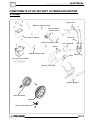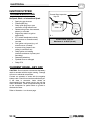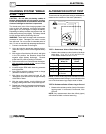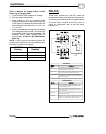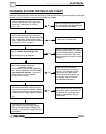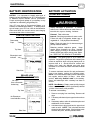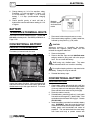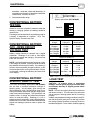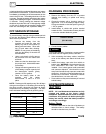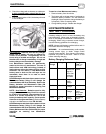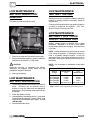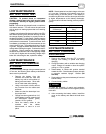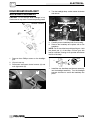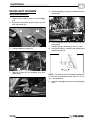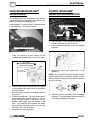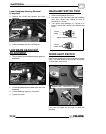
ELECTRICAL
10.25
or load test should be conducted whenever poor battery
performance is encountered. To perform this test, hook
a multitester to the battery in the same manner as was
done in the OCV test. The reading should be 12.6 volts
or greater. Engage the starter and observe the battery
voltage while cranking the engine. Continue the test for
15 seconds. During cranking the observed voltage
should not drop below 9.5 volts. If the beginning voltage
is 12.6 volts or higher and the cranking voltage drops
below 9.5 volts during the test, replace the battery.
OFF SEASON STORAGE
To prevent battery damage during extended periods
of non-use, the following basic battery maintenance
items must be performed:
G Remove the battery from the
machine and wash the case and
battery tray with a mild solution of
baking soda and water. Rinse with
lots of fresh water after cleaning.
NOTE: Do not get any of the baking
soda into the battery or the acid will
be neutralized.
G Using a wire brush or knife, remove
any corrosion from the cables and
terminals.
G Make sure that the electrolyte is at
the proper level. Add distilled water
if necessary.
G Charge at a rate no greater than 1/10
of the battery’s amp/hr capacity until
the electrolyte’s specific gravity
reaches 1.270 or greater.
G Store the battery either in the
machine with the cables
disconnected, or store in a cool
place.
NOTE: Recharge to full capacity every 30 to 60 days
during a non-use period. If the battery is stored during
the winter months, electrolyte will freeze at higher
temperatures as the battery discharges. The chart
below indicates freezing points by specific gravity.
Electrolyte Freezing Points
Specific Gravity
of Electrolyte
Freezing
Point
1.265 -75° F
1.225 -35° F
1.200 -17° F
1.150 +5° F
1.100 +18° F
1.050 +27° F
CHARGING PROCEDURE
1. Remove the battery from the ATV to prevent
damage from leaking or spilled acid during
charging.
2. Charge the battery with a charging output no
larger than 1/10 of the battery’s amp/hr rating.
Charge as needed to raise the specific gravity to
1.270 or greater.
3. Install battery in vehicle with positive terminal
toward the front. Coat threads of battery bolt with
a corrosion resistant dielectric grease.
Dielectric Grease
(PN 2871329)
4. Connect battery cables.
WARNING
To avoid the possibility of explosion, connect positive
(red) cable first and negative (black) cable last.
5. After connecting the battery cables, install the
cover on the battery and attach the hold down
strap.
6. Install clear battery vent tube from vehicle to
battery vent. WARNING: Vent tube must be free
from obstructions and kinks and securely
installed. If not, battery gases could accumulate
and cause an explosion. Vent should be routed
away from frame and body to prevent contact with
electrolyte. Avoid skin contact with electrolyte, as
severe burns could result. If electrolyte contacts
the vehicle frame, corrosion will occur.
7. Route cables so they are tucked away in front and
behind battery.
LOW MAINTENANCE
BATTER
Y
NOTE: All Low Maintenance batteries are fully
charged and tested at the factory before
installation. Expected shelf life varies on storage
conditions. As a general rule before placing the
battery into service, check the battery condition
and charge accordingly.
Battery Check:
1. Check the date label on the side of the battery to
calculate when to check voltage. The battery
should be checked every 3 months.



